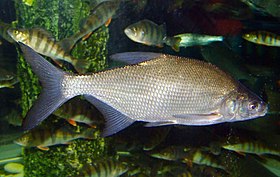Bream
The bream is usually 30 to 55 centimetres (12 to 22 in) long, though some specimens of 75 centimetres (30 in) have been recorded; it usually weighs 2 to 4 kilograms (4.4 to 8.8 lb). It has a laterally flattened and high-backed body and a slightly undershot mouth. It is a silvery grey colour,[citation needed]though older fish can be bronze-coloured especially in clear waters. The fins are greyish to black, but never reddish. The common bream's home range is Europe north of the Alps and Pyrenees, as well as the Balkans. It is found as far east as the Caspian Sea, the Black Sea, and the Aral Sea. The bream is usually 30 to 55 centimetres (12 to 22 in) long, though some specimens of 75 centimetres (30 in) have been recorded; it usually weighs 2 to 4 kilograms (4.4 to 8.8 lb). It has a laterally flattened and high-backed body and a slightly undershot mouth. It is a silvery grey colour,[citation needed]though older fish can be bronze-coloured especially in clear waters. The fins are greyish to black, but never reddish. The common bream can easily be confused with the silver or white bream (Blicca bjoerkna), in particular at the younger stages (see picture). The most reliable method of distinguishing these species is by counting the scales in a straight line downwards from the first ray of the dorsal fin to the lateral line. Silver bream has fewer than ten rows of scales, common bream has eleven or more. At the adult stage the reddish tint of the pectoral fin of the silver bream is diagnostic. Like other Cyprinidae, common bream can easilyhybridise with other species, and hybrids with roach (Rutilus rutilus) can be very difficult to distinguish from pure-bred bream.

No comments:
Post a Comment